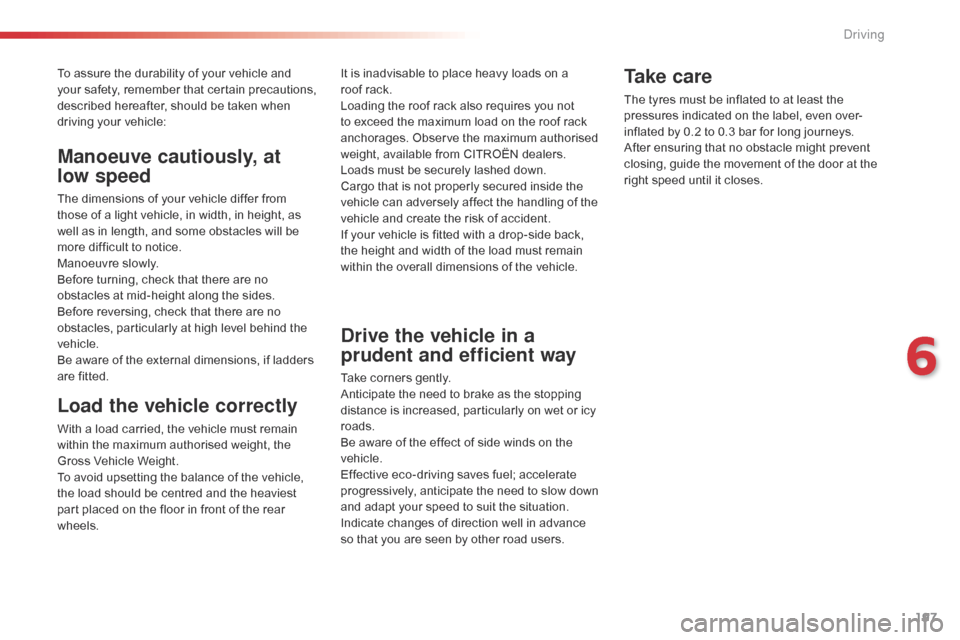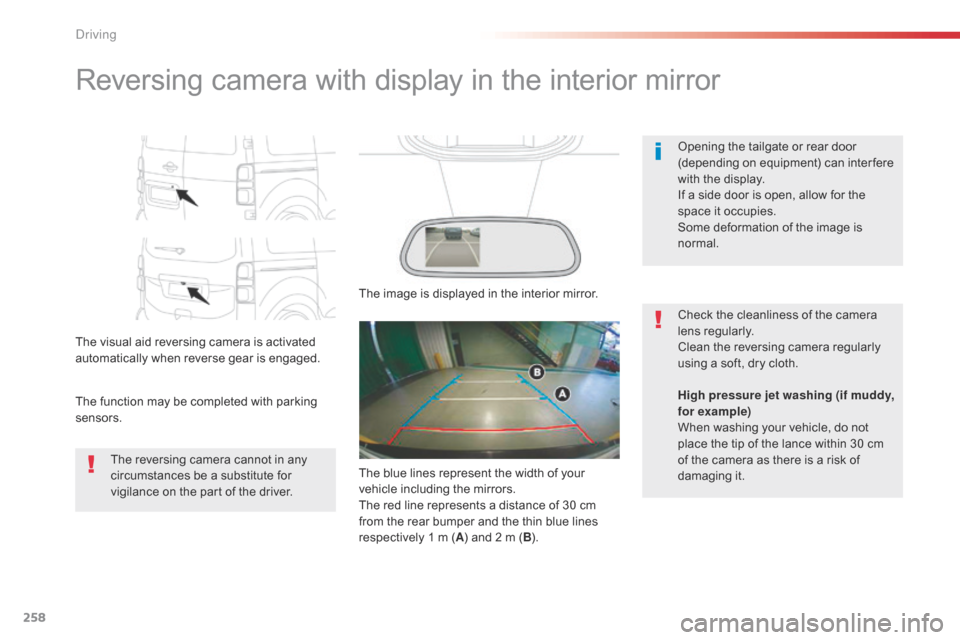width Citroen JUMPY RHD 2016 2.G Owner's Manual
[x] Cancel search | Manufacturer: CITROEN, Model Year: 2016, Model line: JUMPY RHD, Model: Citroen JUMPY RHD 2016 2.GPages: 520, PDF Size: 10.54 MB
Page 199 of 520

197
To assure the durability of your vehicle and
your safety, remember that certain precautions,
described hereafter, should be taken when
driving your vehicle:
Load the vehicle correctly
With a load carried, the vehicle must remain
within the maximum authorised weight, the
Gross Vehicle Weight.
To avoid upsetting the balance of the vehicle,
the load should be centred and the heaviest
part placed on the floor in front of the rear
wheels.
Manoeuve cautiously, at
low speed
The dimensions of your vehicle differ from
those of a light vehicle, in width, in height, as
well as in length, and some obstacles will be
more difficult to notice.
Manoeuvre slowly.
Before turning, check that there are no
obstacles at mid-height along the sides.
Before reversing, check that there are no
obstacles, particularly at high level behind the
vehicle.
Be aware of the external dimensions, if ladders
are fitted.It is inadvisable to place heavy loads on a
roof
rack.
Loading the roof rack also requires you not
to exceed the maximum load on the roof rack
anchorages. Observe the maximum authorised
weight, available from CITROËN dealers.
Loads must be securely lashed down.
Cargo that is not properly secured inside the
vehicle can adversely affect the handling of the
vehicle and create the risk of accident.
If your vehicle is fitted with a drop-side back,
the height and width of the load must remain
within the overall dimensions of the vehicle.
Drive the vehicle in a
prudent and efficient way
Take corners gently.
Anticipate the need to brake as the stopping
distance is increased, particularly on wet or icy
roads.
Be aware of the effect of side winds on the
vehicle.
Effective eco-driving saves fuel; accelerate
progressively, anticipate the need to slow down
and adapt your speed to suit the situation.
Indicate changes of direction well in advance
so that you are seen by other road users.
Take care
The tyres must be inflated to at least the
pressures indicated on the label, even over-
inflated by 0.2 to 0.3 bar for long journeys.
After ensuring that no obstacle might prevent
closing, guide the movement of the door at the
right speed until it closes.
6
Driving
Page 243 of 520

241
When the dynamic cruise control is
automatically paused, it can only be
reactivated when safe conditions are
restored. The message "Activation
not possible, conditions unsuitable"
is displayed while reactivation is not
possible.
When the conditions allow, it is
recommended that the function be
reactivated by pressing button 2 (SET+)
or 3 (SET-), which will make the current
speed of your vehicle the new cruise
speed setting, rather than by pressing
button 4 (on/pause) which reactivates
the cruise control using the old cruise
speed setting, which may be very
different from the current speed of your
vehicle.The speed regulation range is limited to a
maximum difference of 20 mph (30 km/h)
between the speed setting and the speed of
the vehicle in front.
Above this, the system goes into pause if the
safe distance becomes too small.
The dynamic cruise control uses only engine
braking to slow the vehicle. Consequently the
vehicle loses speed slowly, as when releasing
the accelerator pedal.
The system is paused automatically:
-
i
f the vehicle in front slows down too much
or too suddenly, and the driver does not
brake,
-
i
f a vehicle comes between your vehicle
and the vehicle in front,
-
i
f the system does not slow the vehicle
enough to continue to maintain a safe
distance, for example when descending a
steep hill.Limits of operation
As the radar's field of detection is quite narrow,
it is possible that the system may not detect:
-
v
ehicles of reduced width, such as
motorcycles, for example, -
v
ehicles not running in the middle of the
lane,
-
v
ehicles entering a corner,
-
v
ehicles changing lane at the last moment.
The cruise control does not take
account of:
- s tationary vehicles,
-
v
ehicles driving in the opposite
direction.
6
Driving
Page 260 of 520

258
Reversing camera with display in the interior mirror
The visual aid reversing camera is activated
automatically when reverse gear is engaged.
The function may be completed with parking
sensors.Opening the tailgate or rear door
(depending on equipment) can inter fere
with the display.
If a side door is open, allow for the
space it occupies.
Some deformation of the image is
normal.
The reversing camera cannot in any
circumstances be a substitute for
vigilance on the part of the driver. Check the cleanliness of the camera
lens regularly.
Clean the reversing camera regularly
using a soft, dry cloth.
The image is displayed in the interior mirror.
High pressure jet washing (if muddy,
for example)
When washing your vehicle, do not
place the tip of the lance within 30
cm
of the camera as there is a risk of
damaging it.
The blue lines represent the width of your
vehicle including the mirrors.
The red line represents a distance of 30 cm
from the rear bumper and the thin blue lines
respectively 1 m (
A) and 2 m ( B).
Driving
Page 262 of 520

260
"Standard view""180° view"
"Zoom view" (reconstructed)
The camera records the surroundings during a
manoeuvre in order to create a reconstruction
of the view from above the rear of the vehicle in
its close surroundings, allowing the vehicle to
be manoeuvred among the obstacles nearby.
This view is available with AUTO view or by
selecting of the view in the change view menu.
180° view makes it possible to reverse out of
a parking space while being able to see the
arrival of vehicles, pedestrians or cyclists.
This view is not recommended for carrying out
a complete manoeuvre.
It is made up of the following:
The area to the rear of your vehicle is displayed
in the screen.
The blue outline represents the width of your
vehicle (with mirrors): its orientation depends
on the position of the steering wheel.
The red line represents a distance of 30
cm
from the rear bumper and the two blue lines,
1
m and 2 m respectively.
Rear views
Engage reverse gear to activate the camera,
located on the tailgate or rear door.
The rear parking sensors also
provide information on the vehicle's
surroundings.
Obstacles may appear further away
than they are in reality.
It is important to check the side views
using the mirrors during the manoeuvre.
Driving